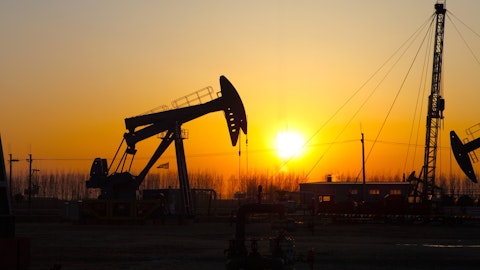Marathon Petroleum Corporation (NYSE:MPC) Q4 2022 Earnings Call Transcript January 31, 2023
Operator: Welcome to the MPC Fourth Quarter 2022 Earnings Call. My name is Sheila, and I will be your operator for today’s call. Please note that this conference is being recorded. I will now turn the call over to Kristina Kazarian. Kristina, you may begin.
Kristina Kazarian: Welcome to Marathon Petroleum Corporation’s fourth quarter 2022 earnings conference call. The slides that accompany this call can be found on our website at marathonpetroleum.com under the Investor tab. Joining me on the call today are Mike Hennigan, CEO; Maryann Mannen, CFO; and other members of the executive team. We invite you to read the safe harbor statements on Slide 2. We will be making forward-looking statements today. Actual results may differ, and factors that could cause actual results to differ are included there as well as in our filings with the SEC. References to MPC’s capital spending during the prepared remarks today reflects standalone MPC Capital excluding MPLX. And with that, I’ll turn it over to Mike.
Mike Hennigan: Thanks Kristina. Good morning. Thank you for joining our call. First off, I want to recognize a new director on the MPC board. Toni Townes-Whitley will be joining our board in March, bringing tremendous experience with her most recent executive position at Microsoft, as well as her board experience on the NASDAQ and PNC boards. Also like to recognize Christine Breves, who was appointed as a new independent director of MPLX in November, and recently served as CFO for US Steel. As we look back at 2022, we’ve delivered on our strategic commitments. Full year cash provided by operating activities was just over $16 billion on a consolidated basis, and over $13 billion, excluding MPLX, reflecting our improving operating and commercial execution.
Our commitment to safe and reliable operations resulted in refining utilization of 96%. And our team’s dynamic responses to volatile product markets delivered strong commercial performance, resulting in a 98% full year capture. Our focus on fostering a low-cost culture enable us to sustain our previously achieved $1.5 billion of structural cost reduction throughout the year. We formed a strategic partnership with Neste, which will enhance the economics of our Martinez Renewables fuels project and create a platform for additional collaboration within renewables. In Midstream, our business grew 7% year-over-year, MPLX raise its distribution by 10%. And based on this level, we expect MPC will receive $2 billion of annual distributions. MPLX remains a source of durable earnings in the MPC portfolio.
And as MPLX grows its free cash flow, we believe we will continue to have the capacity to increase its capital return to unit holders. In 2022, we return nearly $12 billion through share repurchases, bringing the total repurchases to almost $17 billion since May of 2021. In addition, we increased MPC’s dividend 30% to $0.75 per quarter. Executing on our operating, commercial and financial objectives, combined with a strong macroenvironment led to total shareholder returns of 87% for MPC in 2022. Before Maryann goes through the results for the quarter, we wanted to share our outlook on the macroenvironment and the financial priorities for 2023. Our outlook remains bullish for €˜23 supported by the nearly 4 million barrels per day of refining capacity that has come offline globally in the last couple of years.
Demand for transportation fuels we manufacture remains robust. We’ve seen recovery in demand across all our products since coming out of the pandemic. And we anticipate further recovery in 2023, particularly as we expect consumers to adjust consumption patterns to lower retail fuel prices. Uncertainties remain around the pace and impact of China’s recovery, the magnitude of a potential US or global recession and the impact of Russian product sanctions. But despite these unknowns, we believe that the current supply constraints and growing demand will support strong refining margins in €˜23. Our financial priorities remain unchanged. These includes first sustaining capital. We remain steadfast in our commitment to safely operating our assets, protect the health and safety of our employees, and support the communities in which we operate.
Second, our dividend, we are committed to the dividend which we increased 30% at the end of last year, and intend to evaluate at least annually. And as we repurchase shares, the reduction in the share count increases the ability to support future dividend growth. Third, growth capital. We believe this is a return on and return of capital business. We’ve been through a progressive change over the last few years and remain focused on ensuring the competitiveness of our assets as we progress through the energy evolution. We will invest capital where we believe there are attractive returns. In traditional refining, we’re focused on investments that enhance the competitiveness of our assets. In the low carbon area, investment at this time is primarily associated with the completion of the Martinez Renewables project, as well as a project at our LA refinery that will improve energy efficiency and lower facility emissions.
In addition, we’re focused on growth opportunities in emerging technologies, as well as opportunities enabled by digital transformation. Beyond these three objectives, we’re also returning s excess capital through share repurchases to meaningfully lower our share count. In the period from early November through the end of January, we’ve completed nearly $2.4 billion of share repurchases. And today, we announced an incremental $5 billion share repurchase authorization, reinforcing our commitment to strong capital returns. Our goal is to be the investment of choice in the refining space, generating the most through cycle cash flow, creating value through strategic deployment of capital and delivering superior returns to our shareholders. We also challenged ourselves to lead in sustainable energy by setting meaningful targets to reduce GHG emissions, methane emissions and freshwater intensity targets which we believe we can demonstrate a tangible path to accomplish.
As we innovate for the future, Phase 1 of our Martinez Renewables fuel facilities progressing startup activities, marking a significant milestone in our sustainable energy goals. The facility is on track to reach full Phase 1 production capacity of 260 million gallons per year of renewable fuels by the end of the first quarter 2023. Pretreatment capabilities are expected to come online in the second half of €˜23, which will enable the facility to ramp up to its full expected capacity of 730 million gallons per year by the end of 2023. At Dickinson, we’ve optimized operations to be able to bringing in more advantage feedstocks, lowering the carbon intensity of the fuels we produce. We’ve enhanced our position in the renewables value chain through our pretreatment facilities in Beatrice and Cincinnati.
We’ll continue to look for opportunities leveraging the strategic partnerships we’re cultivating with Neste and ADM. As evidence of our progress on our sustainability goals, this year, MTC was included in the Dow Jones Sustainability Index for North America for the fourth consecutive year. At this point, I’d like to turn the call over to Maryann.

Copyright: Elnur / 123RF Stock Photo
Maryann Mannen: Thanks, Mike. Moving the fourth quarter results. Slide 6 provides the summary of our financial results, this morning, we reported adjusted earnings per share of $6.65. This excludes a $176 million LIFO inventory benefit, as well as $60 million gain related to the Speedway transactions. Adjusted EBITDA was $5.8 billion for the quarter, and cash flow from operations, excluding unfavorable working capital changes, was $4.4 billion. During the quarter, we returned $351 million to shareholders through dividend payments, and repurchased over $1.8 billion of our shares. Slide 7 shows the reconciliation between net income and adjusted EBITDA as well as the sequential change in adjusted EBITDA from the third quarter of 2022 to the fourth quarter of 2022.
Adjusted EBITDA was lower sequentially by approximately $1 billion. This decrease was primarily driven by refining and marketing, as the blended crack spread was down over $5 per barrel, reflecting a 20% quarterly decline. Corporate expenses were higher in the fourth quarter driven by a retroactive operating tax assessments for prior periods. We intend to pursue recovery of these multiyear tax assessments. In addition, corporate includes special compensation expenses, which also affected our refining and marketing and midstream segments. We do not anticipate that these costs will structurally impact future corporate cost. The tax rate for the fourth quarter was 22%, resulting in a tax provision of nearly $1 billion and the full year tax rate was 22%.
Moving to our segment results, slide 8 provides an overview of our Refining and Marketing segments. Like many in the industry, several of our refineries were impacted by winter storm Elliott at the end of December, primarily in our Gulf Coast in Mid-Con regions. Most of our assets were back online after a short period, and we have not seen structural issues. The crude throughput impact was approximately 4 million barrels, which reduced our crude capacity utilization for the fourth quarter by roughly 2%. Looking to January, we anticipate impacts to throughput of 3.5 million barrels which is reflected in our guidance for the first quarter of 2023. Even with a disruption at the end of the quarter, our refining assets ran at 94% utilization, processing 2.7 million barrels of crude per day at our 13 refineries.
Sequentially we saw per barrel margins decline most notably in the West Coast region, while US Gulf Coast margins were relatively flat, supported by export demand. Capture was 109% reflecting a strong result from our commercial team. Operating expenses were lower in the fourth quarter primarily due to lower energy cost partially offset by a special compensation expense of approximately $0.15 per barrel, paid in recognition for our employees contributions. Due to lower throughputs in the quarter refining operating costs per barrel were roughly flat in the fourth quarter at $5.62 per barrel as compared to the third quarter. Our full year refining operating costs per barrel is $5.41 when we compare to 2021 refining operating costs per barrel of $5.02, this increase can be entirely attributed to higher energy costs.
We believe the actions we have taken to reduce our structural operating costs are sustainable. Slide 9 provides an overview of our refining and marketing capture this quarter, which was 109%. Our commercial teams executed effectively in a volatile market, light product margin tailwinds improved secondary product prices and favorable inventory impacts all benefited capture. We do not expect all of these tailwinds to be repeatable. And in particular, we would expect the inventory impacts to reverse in the first quarter. As our strategic pillar indicates we have been committed to improving our commercial performance and we believe that the capabilities we have built over the last 18 months will provide a sustainable advantage. Historically, we communicated a captured target of 95%.
But over the last few years, the baseline has moved through our commercial efforts closer to 100%. We believe we have built capabilities that will provide incremental value beyond what we have realized to date, and will produce results that can be seen in our financials. Slide 10 show the change in our Midstream EBITDA versus the third quarter of 2022. Our Midstream segment delivered resilient fourth quarter results. We did see lower EBITDA, primarily due to impacts associated with lower NGL prices. This quarter MPLX distributions contributed $502 million in cash flow to MPC. Slide 11 presents the elements of change in our consolidated cash position for the fourth quarter. Operating cash flow, excluding changes in working capital was $4.4 billion in the quarter.
Working Capital was a $72 million headwind for the quarter, driven mostly by declining crude prices offset by benefits from inventory impacts. Capital expenditures and investments totaled $1.3 billion this quarter. We saw consistent spending in refining in the fourth quarter as work progress on the Martinez Renewables fuel facility conversion and the STAR project at Galveston Bay. While not reflected in the 2022 capital spend, due to the timing of the JV close, the 50% reimbursement from Neste for Martinez capital spend, was received and reflected in overall cash flows in the third quarter. MPC returned nearly $2.2 billion via share repurchase and dividends during the quarter. We began using the incremental $5 billion share repurchase authorization in November.
For the full year, we returned $13.2 billion out of $17.7 billion of our 2022 cash from operations, excluding working capital impacts, representing a 75% payout. This was partially enabled by our commitment to complete our $15 billion capital return program. The outstanding purchase authorization of $7.6 billion, which includes the incremental $5 billion approval demonstrates our commitment to returning capital. At the end of the fourth quarter, MPC had approximately $11.8 billion in cash and short-term investments. Slide 12 provides their capital investment plan for 2023, which reflects our continuing focus on strict capital discipline. MPC’s investment plan, excluding MPLX, totals approximately $1.3 billion. The plan includes $1.25 billion for the refining and marketing segment, of which approximately $350 million or roughly 30% is related to maintenance and regulatory compliance.
Our growth capital plan is approximately $900 million split between low carbon and traditional projects. Within low carbon $150 million is allocated for completion of the Martinez conversion. We are also executing a project at our Los Angeles refinery, which will improve energy efficiency and lower facility emissions. This is a multiyear project. In 2023, we expect associated capital spending to be $150 million. And we have allocated $50 million to smaller projects focused on emerging opportunities. Within traditional refining, $150 million is associated with the completion of the STAR project. $200 million is focused on smaller projects targeted at enhancing the yields of our refineries, improving energy efficiency, and lowering our cost. In marketing, we plan to spend $150 million for projects that focus on enhancing and expanding the platform for our Marathon and ARCO brands.
This morning MPLX also announced their 2023 capital investment plan of $950 million. Their plan includes approximately $800 million of growth capital and $150 million of maintenance capital. The capital spending plan focuses on adding new gas processing plants and smaller investments targeted at expansion and debottlenecking. of existing assets to meet customer demand. Turning to guidance, slide 13, we provide our first quarter outlook. We expect crude throughput volumes of roughly 2.5 million barrels per day, representing 88% utilization. Utilization is forecasted to be lower than fourth quarter levels due to turn around impacts in our US Gulf Coast region, plan turnaround expense is projected to be approximately $350 million in the first quarter, with a significant level of activity in the Gulf Coast region.
The remaining scope of the STAR project, specifically 40,000 barrels per day of crude and 17,000 barrels per day of resid processing capacity is expected to be tied in during the turnaround at Galveston Bay in the first quarter, and should begin to ramp starting in the second quarter of 2023. We expect the level of 2023 turnaround spending to be similar to the level of spend in 2022. However, unlike 2022, we expect turnaround activity to be front half weighted this year, with significant planned work in the first and second quarters. Therefore, we will have executed four consecutive quarters of heavy turnaround work. Operating costs per barrel in the first quarter are expected to be flat at $5.60 per barrel for the quarter. In conjunction with our turnarounds, we anticipate higher project related expenses as we utilize our planned downtime to complete other work plans.
We are seeing the benefits from lower energy costs in the Gulf Coast and Mid-Con regions. But given the majority of our turnaround activity is heavily weighted to the Gulf Coast. Our expectations of flat operating costs quarter-to- quarter is driven by our West Coast exposure, where we have not seen a decline in energy costs recently. As we look into 2023, we anticipate our operating costs per barrel would decline and trend towards a more normalized level as we complete this turnaround and project activity. Distribution costs are expected to be approximately $1.3 billion for the quarter. Corporate costs are expected to be $175 million representing the sustained reductions that we have made in this area. With that, let me pass it back to Mike.
Mike Hennigan: Thanks Maryann. In summary, we believe solid execution of our three strategic pillars remains foundational. Similar to what we’ve achieved with cost reductions and portfolio. We believe the improvements we’ve made to our commercial and operational execution have driven structural sustainable benefits, which will enable us to capture opportunities, irrespective of the market environment. Our goal is to position MPC as the refiner investment of choice, generating the most cash through cycle and delivering superior returns to our shareholders with our steadfast commitment to returning capital. Let me turn the call back to Kristina.
Kristina Kazarian: Thanks Mike. And with that, Sheila, we’re ready for questions.
See also 15 Largest Australian Companies by Revenue and 12 Cash Rich Dividend Stocks To Buy.
Q&A Session
Follow Marathon Petroleum Corp (NYSE:MPC)
Follow Marathon Petroleum Corp (NYSE:MPC)
Receive real-time insider trading and news alerts
Operator: Our first question will come from Neil Mehta with Goldman Sachs.
Neil Mehta: Yes, good morning team and congrats on strong results here. The first question I had was around the magnitude of capital returns. How should we think about the percentage of cash flow or free cash flow you target to get back to shareholders in a given year through buybacks and dividends? And then you talk about a $1 billion being the target level of cash. We’ve heard some of your peers talk about that number being higher, why is a $1 billion the right number and how long does it take to get there? Given how strong the environment is?
Maryann Mannen: Hey, it’s Maryann. Thanks for the question. Let me try to break that into a couple of parts there and then see if I can — if I’ve done your question justice. So in first part really the cadence if you will of the share buyback and our return of capital, as you can see from the quarter, Neil, we did $1.8 billion in share repurchase and then we continue to buy back in the month of January. Just wanted to remind you we did complete our $15 billion share repurchase in early October and I indicated on the quarterly call that we would begin using that incremental $5 billion authorization in November. So essentially for the better part of October, our cadence, we worked in the market buying back in October, just to be clear.
And then we did seek and have announced an incremental $5 billion authorization. So that leaves us with $7.6 billion of share buyback authorization, hopefully indicating our continued commitment to buyback. And we hope you see that. The second part of your question, just really think around our commitment there. I think that’s what you were saying. So when do we get to that $1 billion? How long does it take us and why? We feel a $1 billion is an appropriate level of cash. First, because during the pandemic, we probably stress tested our liquidity and our cash position in one of the most challenging markets. Second, I’d say keep in mind that we receive a $2 billion distribution from MPLX, probably unique when you look at us compared to our peers.
So, in reality, that’s about $3 billion. And then you combine that with our liquidity, we feel pretty comfortable within a range of outcomes that $1 billion is appropriate. I hope that addresses your questions, Neil.
Mike Hennigan: Neil, it’s Mike. Let me just add to what Maryann just said. So we had been at about $1.6 billion from MPLS, moved up to $1.8 billion, we’re now at $2 billion pace, we expect that to continue to grow. If people listen to the MPLX call, we’re in a real good position there. But that distribution, let’s say at the $2 billion pace, that essentially covers the dividend, and half of the refining capital commitment for refining. So that’s part of the reason that we are comfortable with $1 billion on the balance sheet. Now, as you pointed out, we still finished the year with close to $12 billion on the balance sheet. So we still have a lot of financial capability to get to a new normal at some point, but hopefully that helps explain why the $1 billion is the right number. And it has to do with our affiliation with MPLX.
Neil Mehta: Yes, good problems, Mike. And then the follow up is around the STAR project, remind us economics, it seems like it’s coming on at a good time. But how should we think about what this project could mean for incremental cash flow? And in both a midcycle environment, but also, its current spot economics?
Mike Hennigan: Yes, Neil, thanks for that question. It’s one we’ve been getting from a lot of people. So it’s relatively easy to model. So up until now, the parts of STAR that are in place are in our results. What’s not in our results, is 40,000 barrels a day of crude capacity. And the easiest way to model is take that number times the differential between heavy crude, and ULSD. So if you look at that differential, and you multiply it by 40,000 barrels a day, that’s the additional EBITDA that we’ll get once STAR is online. But STAR is a pretty unique project for us. So I’m going to ask Tim to make a couple of comments on it. So you have the financial side of it, but let me give you a little bit of the background behind it with Tim some details, please.
Tim Aydt : Okay. Thanks Mike. So Neil, is good question that you have there. So let me give you a little backdrop, keep in mind that we’ve done this project in phases, a fair amount of the STAR scope has already been completed and put in service, so it’s already earning a return, the remaining work that we have is really going to be completed with this planned turnaround that ends late in the first quarter, and then we’ll be starting up the units in April. So we do expect STAR’s EBITDA contribution to continue to ramp after startup in April and through the second quarter. The remaining scope is really going to be one like Mike just indicated, is going to increase crude capacity by 40,000 a day, and also the resid upgrading capacity by 17,000 a day.
So maybe a little background on that decision rather than expanded the Galveston Bay cokers, we elected to upgrade the resilient hydrocracker unit because it offers better conversion and increased liquid volume yield. So it was a better choice than the coker. The fractionation modifications that we made are also going to increase the diesel recovery, which is profitable. And then the refinery will also be able to process a significantly more of the discounted heavy Canadian crude. So those are some of the reasons that drove us to that. So we feel really good about the economic drivers of the project. And with the current heavy crude discounts and the strong diesel margins, the near-term economics are better than when we sanction the project.
So hopefully that’s helpful.
Operator: Our next question will come from Doug Leggate from Bank of America.





